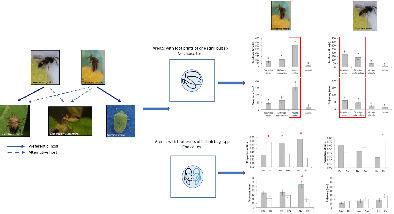当前位置:
X-MOL 学术
›
Physiol. Entomol.
›
论文详情
Our official English website, www.x-mol.net, welcomes your
feedback! (Note: you will need to create a separate account there.)
Selective responses of Trissolcus basalis and Telenomus podisi to chemical footprints of preferred hosts
Physiological Entomology ( IF 1.6 ) Pub Date : 2019-12-03 , DOI: 10.1111/phen.12316 Ana Carolina Gomes Lagôa 1, 2 , Maria Carolina Blassioli Moraes 1 , Miguel Borges 1 , Raúl Alberto Laumann 1
Physiological Entomology ( IF 1.6 ) Pub Date : 2019-12-03 , DOI: 10.1111/phen.12316 Ana Carolina Gomes Lagôa 1, 2 , Maria Carolina Blassioli Moraes 1 , Miguel Borges 1 , Raúl Alberto Laumann 1
Affiliation

|
Chemical trails of the hosts (footprints) are important cues for the host searching behaviour of egg parasitoids of the family Scelionidae. The present study aims to determine the influence of the footprints of three neotropical stink bugs (Euchistus heros, Dichelops melacanthus and Nezara viridula) on the foraging behaviour of two parasitoids, Trissolcus basalis and Telenomus podisi, as well as a possible selective response to fooprints of their preferred hosts. Accordingly, Tr. basalis and Te. podisi females are allowed to forage on open arenas where E. heros, D. melacanthus or N. viridula had walked or on open arenas that had been treated with samples of an extract from each stink bug's footprints. Hexane extracts of stink bug footprints are obtained from solvent‐washed Petri dishes where insects were allowed to walk for 24 h, and these extracts were analyzed by gas chromatography‐flame ionization detection and gas chromatography‐mass spectrometry. Each parasitoid responds selectively to the footprints of their preferred host (Tr. basalis to footprints of N. viridula and Te. podisi to footprints of E. heros). Twenty‐six compounds comprising of C18 to C35 (saturated and unsaturated) and methyl branched hydrocarbons were identified in extracts of E. heros, D. melacanthus and N. viridula, respectively. There are significant differences in the total amount of the compounds identified in the footprint stink bug's extracts and also a difference in the amounts of individual compounds. In addition, the behavioural assays showed that footprints of stink bugs are stimuli that are used by egg parasitoids to search, discriminate and selectively locate their preferred host.
中文翻译:

Trissolcus basalis 和 Telenomus podisi 对首选宿主化学足迹的选择性反应
寄主的化学痕迹(足迹)是 Scelionidae 科卵寄生物的寄主搜索行为的重要线索。本研究旨在确定三种新热带臭虫(Euchistus heros、Dichelops melacanthus 和 Nezara viridula)的足迹对两种寄生蜂 Trissolcus basalis 和 Telenomus podisi 的觅食行为的影响,以及对他们的首选主机。因此,Tr。basalis 和 Te。podisi 雌性被允许在 E. heros、D. melacanthus 或 N. viridula 曾走过的露天场地或已经用每个臭虫脚印的提取物样本处理过的露天场地上觅食。臭虫脚印的己烷提取物是从溶剂洗涤的培养皿中获得的,昆虫被允许行走 24 小时,这些提取物通过气相色谱-火焰电离检测和气相色谱-质谱分析。每个寄生蜂有选择地响应其首选宿主的足迹(Tr. basalis 对 N. viridula 的足迹和 Te. podisi 对 E. heros 的足迹)。分别在 E. heros、D. melacanthus 和 N. viridula 的提取物中鉴定了 26 种包含 C18 至 C35(饱和和不饱和)和甲基支链烃的化合物。脚印臭虫提取物中鉴定出的化合物总量存在显着差异,单个化合物的含量也存在差异。此外,行为分析表明,臭虫的足迹是卵寄生物用来搜索、区分和选择性定位其首选宿主的刺激物。
更新日期:2019-12-03
中文翻译:

Trissolcus basalis 和 Telenomus podisi 对首选宿主化学足迹的选择性反应
寄主的化学痕迹(足迹)是 Scelionidae 科卵寄生物的寄主搜索行为的重要线索。本研究旨在确定三种新热带臭虫(Euchistus heros、Dichelops melacanthus 和 Nezara viridula)的足迹对两种寄生蜂 Trissolcus basalis 和 Telenomus podisi 的觅食行为的影响,以及对他们的首选主机。因此,Tr。basalis 和 Te。podisi 雌性被允许在 E. heros、D. melacanthus 或 N. viridula 曾走过的露天场地或已经用每个臭虫脚印的提取物样本处理过的露天场地上觅食。臭虫脚印的己烷提取物是从溶剂洗涤的培养皿中获得的,昆虫被允许行走 24 小时,这些提取物通过气相色谱-火焰电离检测和气相色谱-质谱分析。每个寄生蜂有选择地响应其首选宿主的足迹(Tr. basalis 对 N. viridula 的足迹和 Te. podisi 对 E. heros 的足迹)。分别在 E. heros、D. melacanthus 和 N. viridula 的提取物中鉴定了 26 种包含 C18 至 C35(饱和和不饱和)和甲基支链烃的化合物。脚印臭虫提取物中鉴定出的化合物总量存在显着差异,单个化合物的含量也存在差异。此外,行为分析表明,臭虫的足迹是卵寄生物用来搜索、区分和选择性定位其首选宿主的刺激物。










































 京公网安备 11010802027423号
京公网安备 11010802027423号